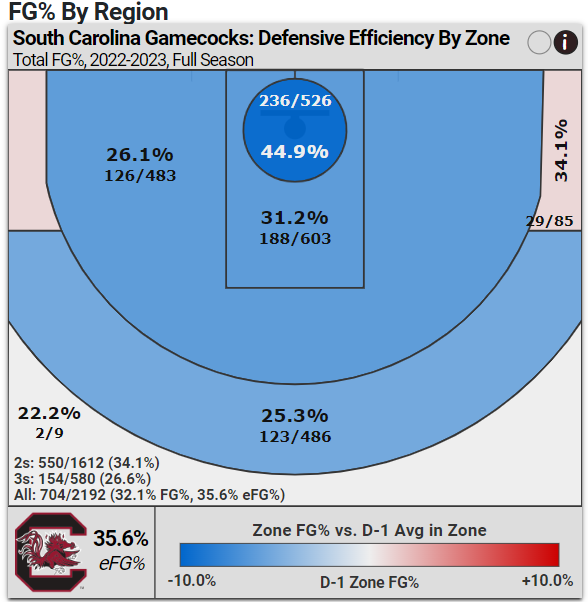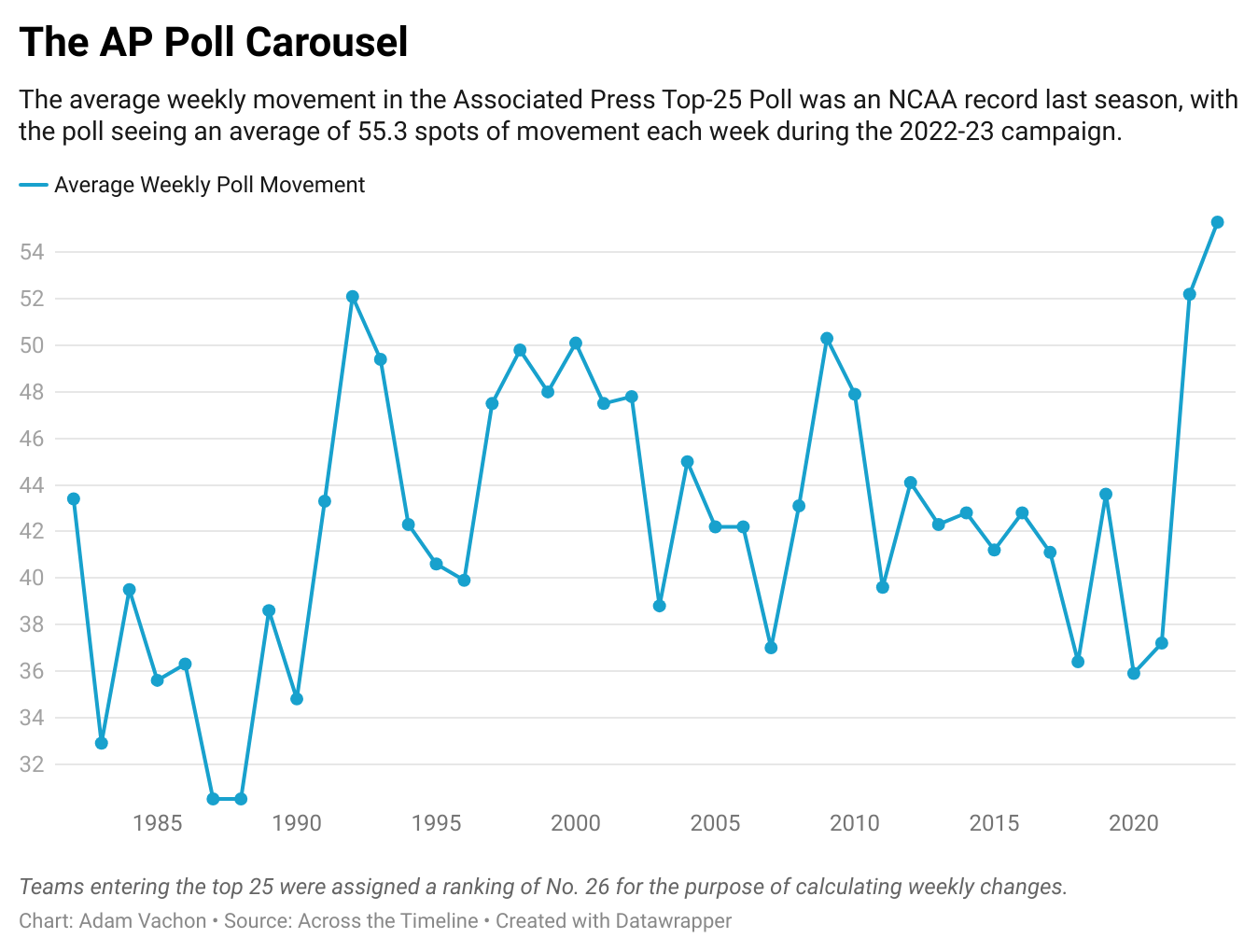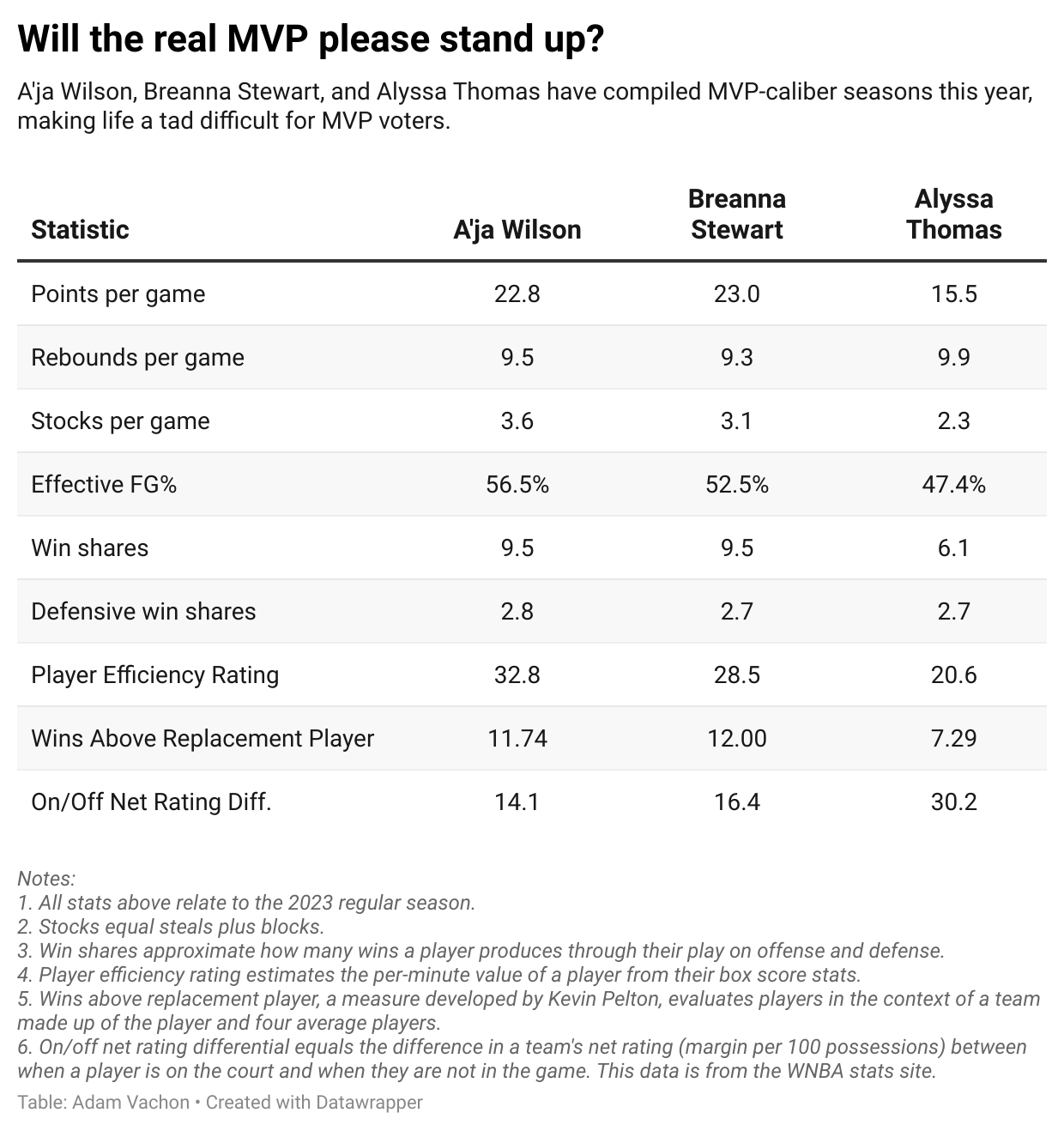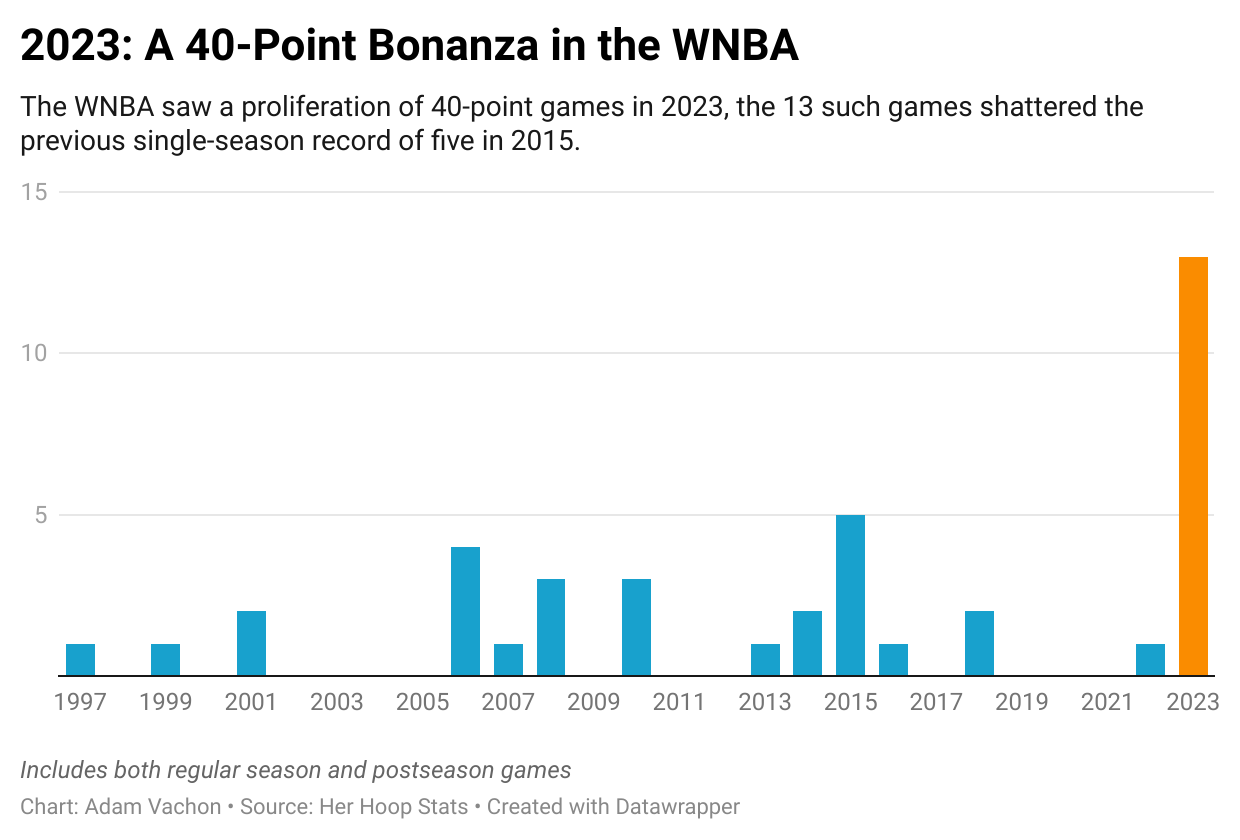Thanks for reading the Her Hoop Stats Newsletter. If you like our work, be sure to check out our stats site, our podcast, and our social media accounts on Twitter, YouTube, Facebook, and Instagram. You can also buy Her Hoop Stats gear, such as laptop stickers, mugs, and shirts!
Haven’t subscribed to the Her Hoop Stats Newsletter yet?
525,600 minutes. How do you measure, measure a year? In upsets, in buzzer-beaters, in John Cena “you can’t see me” gestures. Look, encapsulating an entire calendar year in one article isn’t easy, but I’m going to give it the old college try. A few of these are well-known. Some are deeper cuts, but they’re no less representative of the past 365 days of basketball. So, in typical Her Hoop Stats fashion, it’s time to put a bow on the year that was by breaking down eight numbers that defined 2023.
67 – Caitlin Clark unassisted 3-pointers
When you’re dealing with the best player in women’s college basketball, choosing a stat is a veritable dealer’s choice. Her five triple-doubles last season (Duquesne’s Megan McConnell is the only other player with multiple such games) or record-setting 191 points during the 2023 NCAA Tournament are valid options.
However, I’ve chosen to focus on something that combines her unparalleled shot creation and shotmaking, attributes that, above all else, have made Clark appointment television for millions of fans nationwide: unassisted 3-pointers.
The vast majority of 3-pointers are the result of an assist – roughly 88% of 3-pointers during the 2022-23 season were assisted (based on the median percentage per CBB Analytics). That’s because the coordination and athleticism necessary to knock down an unassisted 3-pointer – controlling one’s dribble, creating enough space to attempt the shot, setting one’s feet or shooting off-balance, and then actually hitting the shot – make it rather uncommon.
Last season, Clark drained 67 unassisted 3-pointers. That not only led the nation, but it was more than any of the 1,088 NCAA teams (Divisions I, II, and III) besides Iowa. Please take a minute to digest the previous sentence. When I first came across this stat, I needed to read it three times before fully wrapping my head around it.
Per usual, Caitlin Clark is in a league of her own.
Note: Kudos to Calvin Wetzel for initially calling attention to this stat and to CBB Analytics for providing the necessary data.
111.5 – Las Vegas’ offensive rating
The 2023 Las Vegas Aces placed itself in the pantheon of the WNBA’s greatest teams. Maybe there’s even an argument for the 2023 WNBA champions being the greatest team of all time, though the 1998 Houston Comets have the edge in terms of winning percentage and net rating. However, there’s almost no debate that the 2023 Aces boasted the best offense in league history.
All of the following are single-season WNBA records set by Becky Hammon’s squad this past season: 55.3% effective field-goal percentage, 1.04 points per play, and 1.20 points per scoring attempt. It all added up to 111.5 points per 100 possessions, an offensive rating just ahead of the 2019 Washington Mystics’ previous record of 110.8.
The offensive attack was led by two-time MVP A’ja Wilson, who became just the fourth player in league history to average over 20 points per game on better than 55% shooting from the field. And then you have the team’s trio of three-level scorers: Chelsea Gray, Jackie Young and Kelsey Plum. Gray and Young were the only two players last season to shoot at least 45% from the field, 40% from three, and 85% from the free-throw line. And despite early-season struggles from long distance, Kelsey Plum righted the ship and set a career-high in points per scoring attempt. When you appreciate the Aces’ plethora of offensive weapons, it’s easier to understand the Aces’ gaudy stats and why they presented a matchup nightmare for the league’s defenses.
And guess what? All four of them as well as Sixth Player of the Year Alysha Clark return next season. Good luck to the rest of the league in slowing down this offense.
55.3 – Average weekly movement in the AP poll
Parity. In sports, it refers to how small (or big) the talent gap is between the best and worst teams. You probably heard this buzzword thrown around college basketball this year, and for good reason. Parity, at least in terms of fluctuations in the Associated Press top-25 poll, reached record levels in 2023, making for a thoroughly unpredictable college season. Just ask Stanford and Indiana, two regional No. 1 seeds upset in the NCAA’s round of 32 (by Ole Miss and Miami, respectively).
But how does the AP poll provide insight into parity? If there were wide gaps between each team’s talent, there would be no upsets and minimal movement. If the top 25 teams all had identical talent, fans would observe a constant reshuffling of the AP poll as teams win and lose all season against comparable foes. Therefore, the poll’s week-to-week movement is a signal of how similar the best teams in the country are.
The 2022-23 season saw an average of 55.3 spots of movement in the AP poll each week, an NCAA record. No. 2 on the list is the 2021-22 season, lending credence to the ideas that 1) the talent pool is as deep as it has ever been and 2) the transfer portal has distributed talent more evenly across the country’s top 25 schools.
The current era of unpredictability and greater parity in college basketball is here to stay.
Note: Special thanks to Across the Timeline for making all of the AP poll data easily accessible.
13 points – The margin in the three-way race for WNBA MVP

It’s both a shame and a delight that fans witnessed three MVP-caliber campaigns in the same season. It’s a bummer that only one of A’ja Wilson, Breanna Stewart, and Alyssa Thomas could take home the WNBA’s highest on-court individual accolade. However, basketball fans in 2023 witnessed some of the best individual seasons in WNBA history. Two-time MVP A’ja Wilson had arguably the best season of her career, leading Las Vegas to the fourth-best regular-season record in league history and becoming the first player in over a decade to rank in the top three in points, rebounds, and assists per game over a single season. Breanna Stewart, the steadying force behind a superteam in New York struggling to gel in the early going of the 2023 season, had very similar numbers as Wilson. Alyssa Thomas’ season was unlike anything the WNBA has seen. Her triple-doubles are well-documented (and more on that below). But Thomas also propelled a Connecticut Sun team that had lost 2021 MVP Jonquel Jones (free agency) and 2022 Sixth Player of the Year Brionna Jones (season-ending injury) to nearly the same record as 2022, playing the second-most minutes per game of any WNBA player since 2005.
In a controversial result, Stewart took home her second MVP award. Perhaps it was the misguided fourth-place vote Wilson received or that Thomas lost despite having the most first-place votes, but the result was always going to be controversial – fans of Wilson and Thomas understandably couldn’t bear to see such brilliance go unrewarded. The margin between the three players was only 13 points, the closest MVP vote among three players in league history. The seven-point difference between Stewart and Thomas, who finished second, was the second-closest ever behind only Sheryl Swoopes’ two-point margin over Lauren Jackson in 2005.
8.8 – South Carolina’s blocks per game
South Carolina entered the 2023 NCAA Tournament as the prohibitive favorite to cut down the nets in Dallas and repeat as national champions. The Athletic’s Austin Mock gave the Gamecocks a 61% chance to win it all; FiveThirtyEight’s model was a tad more bullish at 64%. No other team in either model was given better than an eight percent chance to take home the crown.
We all know what happened next. South Carolina met Iowa in the national semifinals; Caitlin Clark dropped 41 points in one of the best performances in Final Four history; and South Carolina struggled from the field, failing to reach the national title game despite attempting 20 more field goals than the Hawkeyes.
But why was South Carolina such a heavy pre-tournament favorite? Of course, the Gamecocks entered the tournament at 32-0 with victories over Stanford, UCLA, Tennessee (twice), UConn, and a blowout win over LSU. Digging a bit deeper, it was South Carolina’s defense, specifically its interior defense, that powered the Gamecocks to such an impressive run.
The quartet of Aliyah Boston, Kamilla Cardoso, Laeticia Amihere, and Brea Beal made life miserable for any opponent who dared attack the rim. Not only did South Carolina lead Division I in opponent field-goal percentage on shots at the rim (44.9%, well below the Division I average of 57.1%), it set an NCAA Division I single-season record with 8.8 blocks per contest. For some perspective on just how impressive that number is, Stanford was No. 2 last season at 7.2 blocks per game, and Texas was No. 3 at 5.9. The difference between No. 1 and No. 3 was the same as the difference between No. 3 and No. 167.

14 and 13 – WNBA triple-doubles and 40-point games in the W
Yes, I know. These should be two entries, but they fall under the umbrella of “special individual performances happening with unprecedented frequency.” So, I’m including them both here.
First, let’s talk about triple-doubles. There were 14 in the WNBA last season. There were just 11 such games in the league’s first 25 seasons of existence. Possible reasons for this phenomenon are more efficient offenses, Alyssa Thomas, the 3-point revolution (threes are more likely to be assisted), Alyssa Thomas, rule changes since the WNBA’s early days, generous home scorekeepers, the mental benefit of seeing that it can be done with some regularity, and Alyssa Thomas. Perhaps it’s a perfect storm of all of these, but at the center of that storm is, yes, Alyssa Thomas.
Granted, it’s not all Alyssa Thomas. Six other players recorded triple-doubles. However, Thomas had half of the WNBA’s triple-doubles in 2023 – her seven such games breaking the record of four she set in 2022 – and is responsible for nearly one-third of the triple-doubles in league history (11 out of 34).
And also, what’s the deal with all the 40-point games in the W? No, that’s not intended to be the beginning of a bad Jerry Seinfeld-esque joke; it’s a serious question. The league saw 13 such performances in 2023, shattering the previous high of five games in 2015. Maybe it’s that offensive efficiency and pace have increased in recent seasons, creating an ideal environment for such special performances. Perhaps it’s that the W saw more high-volume shooting nights than ever before – an average of 2.11 players in each 2023 regular-season game attempted at least 15 field goals, 15% more than the previous high of 1.83 in 2021. It could be a combination or neither of these. After all, 40-point games are low-frequency events, so maybe it’s just random chance we saw so many this season.
Whatever the reason(s), it will be fascinating to watch whether these phenomena continue next season and beyond.
320 – LSU’s non-conference strength of schedule ranking
Entering the NCAA Tournament, LSU boasted a record of 28-2, including 16-2 against SEC opponents and a NET ranking of No. 3. Looks like a resume worthy of a one-seed, right? Instead, the selection committee gave the Tigers a No. 3 seed, and for good reason. LSU’s nonconference strength of schedule ranked No. 320 out of 361 Division I teams.
Such a weak nonconference schedule prevented many in the women’s basketball world from taking the Tigers seriously as national championship contenders. Conventional wisdom suggests that a team needs a challenging nonconference schedule to be prepared for the cream of the basketball crop in the NCAA Tournament. Early last season, LSU head coach Kim Mulkey offered a different perspective.
“We inherited a program that won nine basketball games (in 2020-21), and if you think I am going to over-schedule before I know what I have, that would be a terrible mistake,” Mulkey said.
LSU’s championship run proved that a strong nonconference schedule isn’t pure virtue. That’s particularly true in an era that has seen unprecedented levels of roster turnover via the transfer portal. Teams need more time to gel and allow their players to learn new offensive and defensive schemes, and sometimes that’s better accomplished with an easier schedule than a baptism-by-fire approach.
9.9 million – Viewers who watched the NCAA national championship
When I reflect on basketball in 2023, this is the number I keep coming back to. Nearly 10 million people watched LSU defeat Iowa in the national championship, 103% higher than the previous year’s national title game between South Carolina and UConn and breaking the previous tournament record of 8.1 million when Stanford faced Virginia in the 1992 national semifinal.
This is what happens when women’s basketball is given a proper platform. People tune in.
Thanks for reading the Her Hoop Stats Newsletter. If you like our work, be sure to check out our stats site, our podcast, and our social media accounts on Twitter, YouTube, Facebook, and Instagram.







Thank you for another informative article on
Women’s basketball! 👍🏀 Awesome!
Regarding the unassisted 3 stat, am I right to assume, this applies to all situations where the players brought the ball from the backcourt to the front court. (Does it include a ball coming off a rebound from a teammate or a throw-in from out of bounds? What about a throw in from the front court?). No wonder Caitlin had 67 makes considering she's a great shooter with great range. But also Iowa's style of play allows her to take that shot. That would never fly at other schools including UConn - Geno wants shooters to shoot but within an offensive flow.